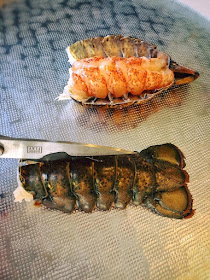Just two more days and you may hear the Fiery Rooster crowing. It's gonna be the year of the rooster. Lunar New Year is the biggest festival for the Vietnamese families, at least traditionally, as it brings family members together to celebrate and give blessings to one another for a healthy, happy, prosperous and spectacular New Year.
For those of you who may not be familiar with the Vietnamese New Year, the traditional celebrations of the festival include new clothes, cleaning the house to get rid off all the bad luck gathered in the past year, decorating the house, cooking traditional food, firecrackers, giving red envelopes, new year wishing, gathering around the table and enjoy the food and time together.
Celebrating Lunar New Year is a good way of preserving heritage and family values. As difficult as it may be, when Lunar New Year comes around, it's my opportunity to teach my girls about their cultural heritage. I would make an effort to decorate the house, prepare a few tradition dishes with my daughter (the food will usually be gone before the new year even arrives), and encourage them to wear traditional dresses called áo dài to school.
So to share in the joys of this wondrous tradition, I am also preparing a non-tradition meal. This lobster ceviche, along with a seafood hotpot would bring your loved ones together for a yummy good time.
*
RECIPE: Lobster Ceviche
*
Ingredients
3 lobster tails
kosher salt or pink Himalayan salt
kosher salt or pink Himalayan salt
fresh lime juice, about 2 limes
fresh ground pepper
cilantro
wasabi
1 medium sweet purple onion
3 green onions, sliced diagonally
*
for broth
4 parts chicken broth
2 parts coconut water
1 sweet onion
1 whole garlic, peeled
1 piece of rock sugar, about a teaspoon
1/2 teaspoon salt
*
Directions
*
Preparing Lobsters
Cooking broth to blanch lobster meat: In a pot, add chicken broth, coconut water or water, lobster shells, some cloves of garlic, onion, rock sugar and salt then bring to a rolling boil. Reduce heat to medium low and simmer for about 5 minutes.
Bring the broth to a rolling boil. Add lobster meat once at a time. Cook for about a minute or less depends on the size of the lobster since you just want to partially cook the lobster meat. Remove it and continue to blanch the remaining lobster meat. Keep the blanched lobsters in the fridge while preparing the remaining ingredients. Keep the broth to make soup or hotpot.
*
Julienne onion and cut green onion diagonally.
Soak onion and green onion in separate bowls of water to reduce the strong sharp taste.
Soak onion and green onion in separate bowls of water to reduce the strong sharp taste.
*
Mixing Lobster Ceviche
Slice lobster into half inch slices.
Drain the water from the onion and green onion and set aside. In a large mixing bowl, combine lobster, onion, green onion, lime juice, salt, a pinch of fresh ground pepper, and toss them well. Taste and adjust seasoning, adding more lime juice, or salt as needed.
Whenever I serve lobster ceviche, I also like to serve seafood hotpot as a main meal. Use the broth that you cooked the lobsters as broth for the hotpot. Toss in some beef fat or beef bone if you have to add a rich, naturally sweet, and robust flavors to the broth.
What you see on the hotpot table are wagyu beef, clams, shrimps, salmon, scallop, lobsters, fish egg balls, udon, tofu, and lettuces.
There are two kinds of dipping sauce that I like to use for this type of hotpot. The first dipping sauce is the mixture of fish sauce, wasabi, and garlic chili sauce. The second dipping sauce is the the mixture of egg yolk form our home-raised eggs but you can also use quail egg if preferred, ponzu sauce, crunchy garlic, truffle oil and toragashi (a spicy powdered assortment of dried red chili pepper, orange peel, sesame seeds, Japanese pepper, ginger and seaweed).
Presentation
Place lobster ceviche on a serving plate. Garnish with cilantro, lime slices, and wasabi. I recommend using a small amount of wasabi on the tip of your chopstick and enjoying the lobster ceviche and wasabi together with each bite.
*
Happy New Year!
Eat well. Stay healthy.
Eat well. Stay healthy.































